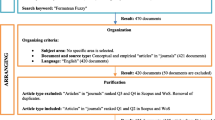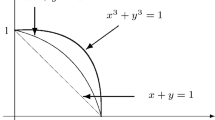Abstract
The present paper defines a new distance function between two trapezoidal fuzzy (TrF) numbers which satisfies all the properties of metric and a degree of deviation between two TrF numbers. The proposed degree of deviation has been used to solve a fully fuzzy multi-objective linear programming problem (FMOLPP). The proposed algorithm uses converting a FMOLPP into crisp linear programming problem and then to get Pareto-optimal solution to the problem. Further, with Pareto-optimal solutions a balance Pareto optimal solution of the problem using fuzzy optimization technique has been obtained with minimum deviation degree in decision variables. The developed computational algorithm has been implemented on an example for the validity of the proposed algorithm.

Similar content being viewed by others
References
Zadeh LA (1965) Fuzzy sets. Inf Control 8:338–353
Zimmermann HJ (1978) Fuzzy programming and linear programming with several objective functions. Fuzzy Sets Syst 1:45–55
Kim K, Park KS (1990) Ranking fuzzy numbers with index of optimisim. Fuzzy Sets Syst 35:143–150
Liou TS, Wang MJ (1992) Ranking fuzzy numbers with integral value. Fuzzy Sets Syst 50:247–255
Jimenez M (1996) Ranking fuzzy numbers through the comparison of their expected interval. Int J Uncertain Fuzzy Knowl Base 4:379–388
Cheng CH (1998) A new approach for ranking fuzzy numbers by distance method. Fuzzy Sets Syst 95:307–317
Tran L, Duckstein L (2002) Comparison of fuzzy numbers using a fuzzy distance measure. Fuzzy Sets Syst 130:331–341
Chu TC, Tsao CT (2002) Ranking fuzzy numbers with an area between the centroid point and original point. Comput Math Appl 43:111–117
Abbasbandy S, Asady B (2006) Ranking of fuzzy numbers by sign distance. Inf Sci 176:2405–2416
Asady B, Zendehnam A (2007) Ranking fuzzy numbers by distance minimization. Appl Math Model 31:2589–2598
He X, Deng H (2011) An area based approach to ranking fuzzy numbers in fuzzy decision making. J Comput Inf Syst 7(9):3333–3342
Rao PPB, Shankar NR (2011) A ranking fuzzy numbers with distance method using circumcenter of centroids an index of modality. Adv Fuzzy Syst. https://doi.org/10.1155/2011/178308
Kumar A, Singh P, Kaur A, Kaur P (2010) Ranking generalized trapezoidal fuzzy numbers based on rank, mode, divergence and spread. Turk J Fuzzy Syst 1(2):141–152
Nejad AM, Mashinchi M (2011) Ranking fuzzy numbers based on the areas on the left and right sides of fuzzy number. Comput Math Appl 61:431–442
Bakar ASA, Mohamad D, Sulaiman NH (2012) Distance based ranking fuzzy numbers. Adv Comput Math Appl 1(3):146–150
Jahantigh MA, Hajighasemi S (2012) Ranking of generalized fuzzy numbers using distance measure and similarity measure. Int J Ind Math 4(4):405416
Grzegorzewski P (2002) Nearest interval approximation of a fuzzy number. Fuzzy Sets Syst 130:321–330
Brunelli M, Mezet J (2013) How different are ranking methods for fuzzy numbers. A numerical study. Int J Approx Reason 54:627–638
Yu VF, Chi HTX, Shen CW (2013) Ranking fuzzy numbers based on epsilon-deviation degree. Appl Soft Comput 13:3621–3627
Zhang F, Ignatius J, Lim CP, Zhao Y (2014) A new method for ranking fuzzy numbers and its application to group decision making. Appl Math Model 38:1563–1582
Yu VF, Dat LQ (2014) An improved ranking method for fuzzy numbers with integral values. Appl Soft Comput 14:603–608
Garcia JCF, Harnandez G (2014) A method for solving linear programming model with interval type-2 fuzzy constraints. Pesquisa Operacional 34(1):73–89
Cheng H, Hung W, Zhou Q, Cai J (2013) Solving fuzzy multi objective linear programming problems using deviation degree measures and weighted max-min method. Appl Math Model 37:6855–6869
Bellman RE, Zadeh LA (1970) Decision making in a fuzzy environment. Manag Sci 17(4):141–164
Lee ES, LI RJ, (1993) Fuzzy multi objective programming and compromise programming with Pareto-Optimum. Fuzzy Sets Syst 53:275–288
Jimenez M, Bilbo A (2009) Pareto-optimal solutions in fuzzy multi-objective linear programming. Fuzzy Sets Syst 160:2714–2721
Allahviranloo T, Alizadeh L (2008) Solving fully fuzzy linear programming problems by the ranking function. Appl Math Sci 2(1):19–32
Lofti FH, Allahviranloo T, Jondabeha MA, Alizadeh L (2009) Solving fully fuzzy linear programming using lexicography method and fuzzy approximate solution. Appl Math Model 33:3151–3156
Kumar A, Kaur J, Singh P (2011) A new method for solving fully fuzzy linear programming problems. Appl Math Model 35:817–823
Ezzati R, Khorram E, Enatyati R (2013) A new algorithm to solve fully fuzzy linear programming problems using the MOLP problem. Appl Math Model 39:3183. https://doi.org/10.1016/j.apm.2013.03.014
Campos L, Verdegay JL (1989) linear programming problems and ranking of fuzzy numbers. Fuzzy Sets Syst 32:1–11
Sharma U, Aggarwal S (2017) Solving fully fuzzy multi-objective linear programming problem using nearest interval approximation of fuzzy number and interval programming. Int. J. Fuzzy Syst pp 1–12
Tarabia AM, Kassem MA, El-Badry NM (2017) A modified approach for solving a fuzzy multi-objective programming problem. In: Applied Informatics 4(1). Springer Berlin Heidelberg
Atanassov KT (1986) Intuitionistic fuzzy sets. Fuzzy Sets Syst 20:87–96
Bharati SK, Singh SR (2014) Solving multi-objective linear programming problems using intuitionistic fuzzy optimization method: a comparative study. Int J Model Optim 4:10–16
Bharati SK, Nishad AK, Singh SR (2014) Solution of multi-objective linear programming problems in intuitionistic fuzzy environment. Adv Intel Syst Comput 236:161–171
Bharati SK, Singh SR (2014) Intuitionistic fuzzy optimization technique in agricultural production planning: a small farm holder perspective. Int J Comput Appl 89:25–31
Bharati SK, Malhotra R (2017) Two stage intuitionistic fuzzy time minimizing transportation problem based on generalized Zadeh’s extension principle. Int J Syst Assur Eng Manag. https://doi.org/10.1007/13198-017-0613-9
Bharati SK, Singh SR (2015) A note on solving a fully intuitionistic fuzzy linear programming problem based on sign distance. Int J Comput Appl 119(23):30–35
Malhotra R, Bharati SK (2016) Intuitionistic fuzzy two stage multiobjective transportation problems. Adv Theor Appl Math 11(3):305–316
Cadenas JM, Verdegay JL (2000) Using ranking functions in multiobjective fuzzy linear programming. Fuzzy Sets Syst 111(1):47–53
Kahraman C, Kaya I (2008) Fuzzy multiple objective linear programming. Fuzzy Multi-Criteria Decision Making, 325–337
Dubey D, Mehra A (2014) A bipolar approach in fuzzy multi-objective linear programming. Fuzzy Sets Syst 246:127–141
Chen HK, Chou HW (1996) Solving multiobjective linear programming problemsa generic approach. Fuzzy Sets Syst 82(1):35–38
Guu SM, Wu YK (1997) Weighted coefficients in two-phase approach for solving the multiple objective programming problems. Fuzzy Sets Syst 85(1):45–48
Luhandjula MK (1982) Compensatory operators in fuzzy linear programming with multiple objectives. Fuzzy Sets Syst 8(3):245–252
Chanas S (1989) Fuzzy programming in multiobjective linear programming-a parametric approach. Fuzzy Sets Syst 29(3):303–313
Nishad AK, Bharati SK, Singh SR (2014) A new centroid method of ranking for intuitionistic fuzzy numbers. In Proceedings of the second international conference on soft computing for problem solving (SocProS 2012), December 28–30, (2012), pp 151–159
Author information
Authors and Affiliations
Corresponding author
Rights and permissions
About this article
Cite this article
Bharati, S.K., Abhishekh & Singh, S.R. A computational algorithm for the solution of fully fuzzy multi-objective linear programming problem. Int. J. Dynam. Control 6, 1384–1391 (2018). https://doi.org/10.1007/s40435-017-0355-1
Received:
Revised:
Accepted:
Published:
Issue Date:
DOI: https://doi.org/10.1007/s40435-017-0355-1




